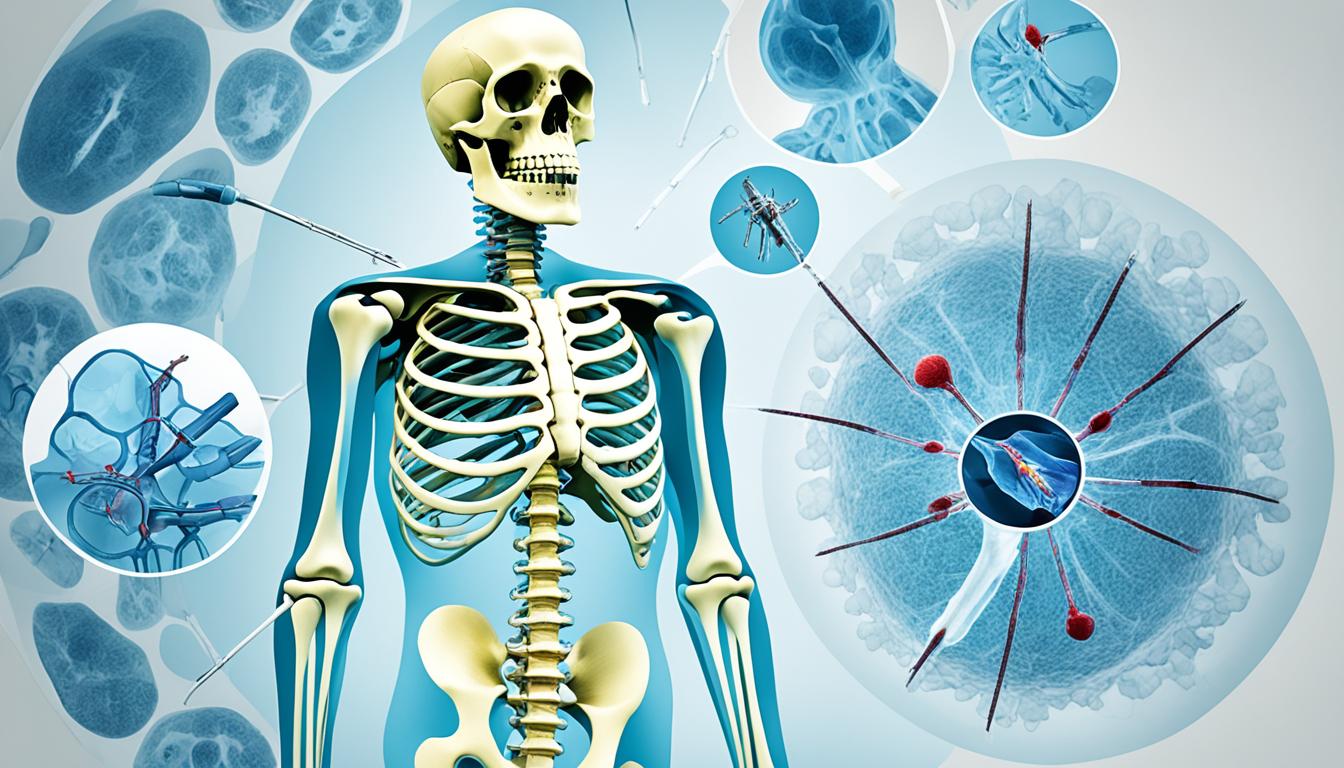Bone spurs are bony growths that form on bones. They show up at joints mostly. This happens where two bones meet. Conditions like arthritis, aging, and being active can lead to them. Not everyone feels them, but they can bring pain and less movement by rubbing on nerves or tissues.
Key Takeaways:
- Bone spurs, or osteophytes, are bony growths that can develop on any bone in the body.
- They are most commonly associated with conditions such as arthritis, aging, and friction.
- Bone spurs can cause pain, inflammation, and reduced range of motion when they press against nerves or surrounding tissues.
Effective Relief and Stem Cell Therapy for Bone Spurs
If your bone spur symptoms don’t improve with non-surgical treatments, surgery might help. The goal of bone spur surgery is to remove the extra bone and take off the pressure on tissues and nerves. The surgery type changes based on where the bone spur is found, like in the foot, shoulder, or neck.
In bone spur surgery, doctors might keep it simple and use small incisions to get to the area. For a foot bone spur, they might do a plantar fasciotomy. This means they make a small cut in the foot to free up the plantar fascia from the bone spur.
For shoulder bone spurs, options include acromioplasty or subacromial decompression. These surgeries make more room for the tendons and reduce pressure from the bone spur by cutting a bit of the acromion bone.
When a neck bone spur is the problem, surgeries like ACDF or cervical laminectomy may be needed. These surgeries help by taking out the bone spur and making the neck bones stable again.
Even though surgeries can make a big difference, they might not solve the main issue, like arthritis. So, taking care after surgery is really important. This care helps with lasting pain relief and stops bone spurs from coming back.
Stem cell therapy is a new treatment that looks promising for bone spurs. Stem cells can change into different types of cells, like bone or cartilage cells. By putting these cells where the bone spur is, they could help make new tissue and fix damaged bones and cartilage.
Other than surgery and stem cell therapy, there are simpler treatments like physical therapy, taking anti-inflammatory drugs, and using orthotics, which can also be good. These methods without surgery help lower pain, make moving easier, and make the muscles around the bone spur stronger.
| Location | Surgical Procedure |
|---|---|
| Foot | Plantar fasciotomy |
| Shoulder | Acromioplasty or subacromial decompression |
| Neck | Anterior cervical discectomy and fusion (ACDF) or cervical laminectomy |
Preventing Bone Spurs and Conclusion
Bone spurs can be part of getting older. But, there’s a lot you can do to lower your chance of having them. It’s about changing your lifestyle and keeping your joints healthy.
Having good posture is key. It keeps the pressure off certain spots and spreads it out. Keeping a healthy weight matters too. Extra pounds can stress your joints more, possibly causing bone spurs.
Cutting back on activities like running and jumping helps avoid bone spurs. These can hurt your joints, leading to the growth of bone spurs. Instead, try exercises that are gentle on your body, such as swimming or cycling. They’re good for your heart and don’t stress your joints as much.
In the end, you can do a lot to stop bone spurs. Good posture, watching your weight, and picking the right exercises can help. This way, you’re looking after your joints and your overall bone health.
FAQ
Q: What are the common symptoms of bone spurs?
A: Common symptoms include pain, swelling, and a decrease in motion. They happen when a bone spur presses on nerves or tissues.
Q: What causes bone spurs to develop?
A: Arthritis, getting older, and friction contribute to bone spur development. They usually grow at the joints between bones.
Q: Do all bone spurs require surgery?
A: Not every bone spur needs surgery. Doctors can use non-surgical methods to help with the symptoms. But some cases might need surgery if the pain continues.
Q: What is the purpose of bone spur surgery?
A: Bone spur surgery aims to remove the extra bone and ease pressure on tissues and nerves. The surgery choice varies by the location, like the foot or shoulder.
Q: Can bone spurs be prevented?
A: Some prevention steps exist despite bone spurs being common as we age. Good posture, keeping a healthy weight, and staying away from high-impact sports can lower the joint stress. This might reduce the chance of bone spurs.

